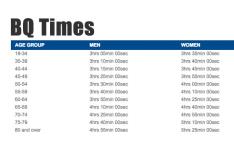The introductory three-week period is not totally devoid of harder running; however, the lion's share of your first three weeks is simple healthy running. In order to have a baseline measure of mileage, the below program is standardized for someone beginning the program in the 40 to 45 miles per week range with a peak during weeks 5 to 10 in the 55 to 60 miles per week range prior to the taper.
Sample Weeks 1, 2, 3
Sunday Long Run
Complete 16 to 20 miles controlled at a conversational pace with moderate surges over the last 90:00—surges are simple 1:00 pick-ups every 7 to 8 minutes. These surges are assertive yet controlled. Between each surge, simply return back to a comfortable training rhythm. Pick-ups should be moderate in nature but only so fast so you can return to your pre-surge tempo easily.
More: What Are Threshold and Tempo Runs?
One of the first three weeks (week 2) should see a 19 to 20 miler; the other weeks (week 1 and 3) should be 16 to 17 miles in length maximum (with the same surging described above). Conclude runs with 6 x 100-meter strides for economy.
Be certain to practice fluid and energy intake during your long runs. Take 6 to 8 ounces of fluid every 30 to 35 minutes, and ideally 100 to 120 calories of energy intake within the same period.
More: How to Choose Your Ideal Marathon Fuel Plan
Sample Weekly Schedule for Weeks 1, 2, 3
Monday: Short recovery run or non-run day (rest). Complete an optional non-running aerobic exercise—preferably spinning on a stationary bike or a pool session.
More: What to Do on Rest and Recovery Days
Tuesday: Easy 6 to 7 miles with 8 x 100m to finish the run.
Wednesday: Longer fartlek set for weeks 1 and 2. After a proper 20-minute warm-up, complete a 22-minute "ladder" fartlek with pick-ups of 7:00 – 6:00 – 5:00 – 4:00 – 3:00 – 2:00 – 1:00. Recovery should be half the time of the interval just completed. Target effort for the 7:00 and 6:00 pieces is roughly current half marathon race pace (in other words at or a hair slower than most runners' anaerobic threshold). The 5:00 and 4:00 pieces should be roughly current 10K race pace, and the 3:00, 2:00, 1:00 pieces should be targeted at current 5K-race fitness. You will note that the tempo of these efforts becomes increasingly quicker while the recovery decreases in duration.
- 2
- of
- 5
About the Author

Get ACTIVE on the Go


Couch to 5K®
The best way to get new runners off the couch and across the finish line of their first 5K.
Available for iOS | Android







Discuss This Article